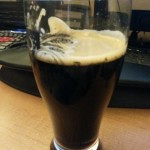I started home brewing beer about 9 years ago. It wasn’t long after that when I kicked Mr. Beer and his kit-based ilk to the curb and started crafting my own recipes. And being not only a writer of science fiction but also a fan, I wanted my beers to be inspired by the fantastical worlds I loved. Around that time, my wife and I were just getting hooked on Firefly (yes, we got our brown coats late, I know). I thought it would be clever to try and brew up some Firefly themed beer.
The Mudder’s Milk Barely Wine was a catastrophe which we do not speak of in my house. However, I tried again, wanting to craft a beer that the common folk of the Rebellion would drink. I thought a porter would be a good base, seeing as how it got its name and reputation by being the drink of choice for the men and women who worked the docks in the Victorian era. In order to make it a cross-cultural beer, I chose a common American hop for bittering and replaced finishing hops with a few ounces of fresh ginger. The beer was a hit. My friends and co-workers loved it. A six pack of it raised over $50 in a charity auction at work. But I wasn’t entirely happy with it. Since that time, each time I brew it I tweak the recipe just a little bit more in the search for perfection.
A few weeks back I brewed it again. I’m really happy with how the beer has evolved over the years. How did the last batch turn out? I’ll walk you through it. Color wise, it shifts from a deep red up into a thick black. If my kegerator isn’t acting up, a nice creamy brown head forms on the top of the beer. When you bring the pint glass up to your nose, there is no punch from hops or malts. However a quick sniff reveals a hint of ginger and a bit of sweetness underneath. Taking a drink, the first thing you’ll feel is the smooth carbonation from the head. I’m really proud to say that the head sticks with the beer all the way to the bottom of the glass. Next comes the sweet taste of caramel. The aftertaste has a slight bitterness to it, not of hops but of ginger. It’s subtle. You can tell it is ginger, but it isn’t GINGER!!!!11. The mouth feel is full but the beer is still very drinkable.
It’s not perfect, though. To be honest, the beer is a bit sweeter than a typical porter, and could use a tad more roast. I think perhaps the blackprinz malt is a wee too smooth. Maybe next time I’ll tweak it by mixing a bit of Simpsons roasted barley in.
Speaking of the recipe, I’ll share it below. I brew using the Brew In A Bag method (BIAB). If you’re not familiar with this type of brewing, I encourage you to check out this video by Nothern Brewer. It really is an easy way to get into all grain brewing. Here are the main differences between traditional all-grain and BIAB:
- You place all the grains into a sturdy yet somewhat porous sack that will fit around the circumference of your kettle. Your typical muslin mesh bag is not appropriate for this task. Some people use paint strainer bags. I had my wife sew me one made of Swiss voile.
- You add the total amount of water you will need for the finished beer to your kettle.
- There is no sparge stage
- Really, there is no sparge stage.
- I kid you not, there is no sparging.
To the Black v 6.0: a Firefly Inspired Porter
This recipe will yield 3 gallons of beer. OG will be in the neighborhood of 1.060
- 5 lbs 8 oz of Pale Malt (2 Row)
- 1 lb of Simpsons Dark Crystal
- 1 lb of Munich
- 8 oz of Briess Blackprinz
- 2 oz of Willamette hops
- 2 oz of peeled, fresh ginger (add more or less to taste)
- 1/2 cup of raw honey (I used a local wildflower honey)
- 1 package of Nottingham dried yeast
- Saccharification step: Soak the grains in 5 gallons of 155F water for 80 minutes.
- Mash Out: Raise the temp to 168F. Try to hold it there for 7 minutes.
- Remove the bag from the kettle. Place it in a large colander or strainer over the top of the kettle. I use a large basket style strainer with extending handles. It fits right over the top of my kettle. NOTE: The bag will be heavy.
- Give the bag several squeezes and allow the freed wort to drip back into the kettle. Do this for as long as you can stand it.
- When you’ve gotten all you want out of the grains, remove the strainer and bag from the top of the kettle.
- Raise the temperature of the wort to a boil.
- Add 1oz of Willamette hops at the start of the boil. The boil will last 60 minutes.
- Add 2nd ounce of Willamette when there are 15 minutes left to the boil.
- Take the ginger and blend it with a half cup of water. Add this when there are 10 minutes left in the boil.
- Add the honey during flame out.
- Fermentation: 2 and a half weeks. I do not transfer to a secondary.
Optional: I always cold crash my beers in my kegerator for two or three days prior to kegging. It really clears the beer out and gets it nice and cold for the CO2.
I love discussing brewing, so if you have any questions, feel free to hit me up. Cheers!



